Accepted Scientific Name: Mammillaria bocasana Poselg.
Allg. Gartenzeitung (Otto & Dietrich) 21: 94. 1853 Otto & A.Dietr.
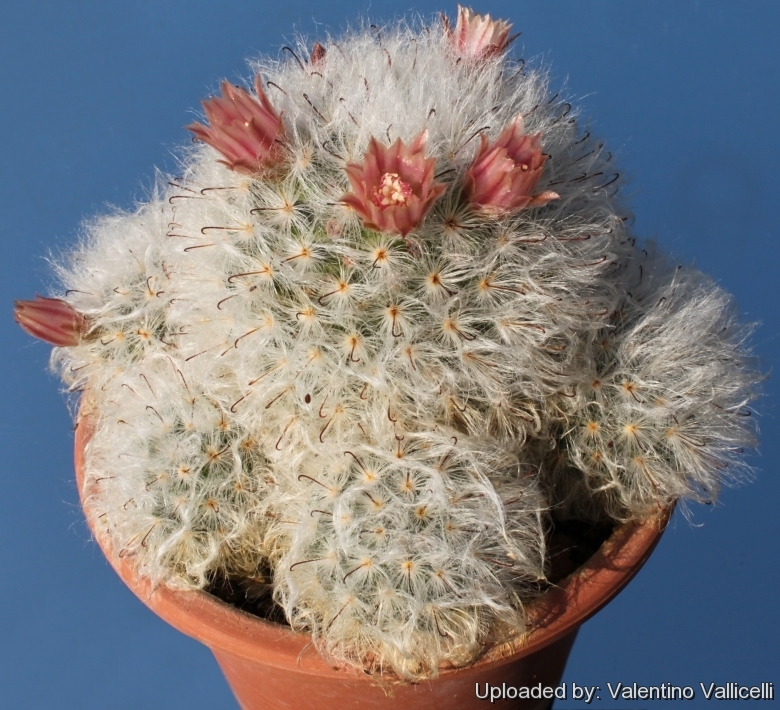
Chilita bocasana (Mammillaria bocasana) Photo by: Valentino Vallicelli
It is a fast-growing cactus covered with clusters of silky white hairs, with each cluster surrounding a yellow-to-red hooked spine. The spines are used to make fishhooks in Mexico.
Origin and Habitat: Northern central Mexico, especially in San Luis Potosi Zacatecas and Queretaro states, Mexico.
Type locality: Sierra de Bocas.
Altitude: 1650 - 2300 metres above sea level.
Habitat: It grows among volcanic rock on canyon walls and at at the foot of a hill in semi-desert. This species is often found under bushes in association with other plant species, including Thelocactus hexaedrophorusSN|10830]]SN|10830]], Mammillaria formosaSN|15832]]SN|15832]], Ferocactus histrixSN|4300]]SN|4300]], Echinocereus pectinatusSN|7775]]SN|8503]], Echinocereus cinerascensSN|8503]]SN|7775]], Myrtillocactus geometrizansSN|8050]]SN|8050]], Agave salmianaSN|27883]]SN|27883]], Coryphantha platanita, Echinofossulocactus dichroacanthusSN|6255]]SN|6255]] and Dasylirion acrotrichumSN|2998]]SN|2998]]. Large subpopulations are found over a relatively large area and current levels of decline are relatively small.
Synonyms:
See all synonyms of Mammillaria bocasana
back
Accepted name in llifle Database:Mammillaria bocasana Poselg.Allg. Gartenzeitung (Otto & Dietrich) 21: 94. 1853Synonymy: 13
Accepted name in llifle Database:Mammillaria bocasana subs. eschauzieri (J.M.Coult.) W.A.Fitz Maur. & B.Fitz Maur.J. Mammillaria Soc. 35(2): 17 (1995) (also spelled: "eschanzieri" or "eschausieri")Synonymy: 27
Cultivars
(6):
back
Common Names include:
ENGLISH: Powder Puff Cactus, Powder Puff Pincushion
RUSSIAN (Русский): Маммиллярия бокасанская
SWEDISH (Svenska): Silkesvårtkaktus
UKRAINIAN (Українська): Мамілярія боказана, Мамілярія бокаська
Description: Mammillaria bocasanaSN|8970]]SN|8970]] (Syn: NeoSN'> 8972' alt='8970'>Mammillaria bocasana#SN#8970'>Neo[[Mammillaria bocasanaSN' style='border:none;'>) is a clumping cactus, often forming large mounds. It is commonly called the “Powder Puff Cactus”, because of its appearance like a cotton ball as the small round plant is covered with silky white hairs. It is quite variable with a lot of different varieties and forms available in cultivation. Generations of cactophiles have had this plant as one of their first acquisitions and few can have been disappointed by its easy cultivation and free-flowering habit.
8972' alt='8970'>Mammillaria bocasana#SN#8970'>Neo[[Mammillaria bocasanaSN' style='border:none;'>) is a clumping cactus, often forming large mounds. It is commonly called the “Powder Puff Cactus”, because of its appearance like a cotton ball as the small round plant is covered with silky white hairs. It is quite variable with a lot of different varieties and forms available in cultivation. Generations of cactophiles have had this plant as one of their first acquisitions and few can have been disappointed by its easy cultivation and free-flowering habit.
Stems: Individual stems spherical, sometimes becoming somewhat cylindrical. light green to bluish-green, 5-8(-12) cm tall and 3-6(-8) cm in diameter.
Tubercles: Slender, soft, cylindrical, terete, 6 to 8 mm long, their axil sometimes hairy or bristly. Without latex.
Radial spines: Numerous (30-50), white, hair-like, silky, 8-20 mm long.
Central spines: 1-7, reddish brown, 5-10 mm long, much shorter than the radial hairy ones, of which one (occasionally two) hooked, brown, but paler at base.
Flower: Funnel-form, creamy-white, creamy-yellow or pinkish, 13-22 mm long, up to 15 mm in diameter, perianth-segments lanceolate-linear, acute, spreading. Flower-buds rose-coloured.
Blooming season: Spring and summer.
Fruits: Cylindrical, rosy-pink to red, 2,5 (or more) cm long in summer.
Seeds: Reddish brown, with partially lateral hilum.
Subspecies, varieties, forms and cultivars of plants belonging to the Mammillaria bocasana group
Notes: Several cultivars exist, with varying quantities of wool, and flower colors. The plants sold as 'forma multilanata' are very woolly, with yellowish flowers.
Bibliography: Major references and further lectures.
1) Robert T. Craig “The Mammillaria handbook: with descriptions, illustrations, and key to the species of the genus Mammillaria of the Cactaceae” E P Publishing, 1945
2) John Pilbeam “Mammillaria The Cactus File Handbook” Cirio Pub. Services, 01/Dec/1999
3) Edward Anderson “The Cactus family” Timber Press, Incorporated, 2001
4) James Cullen, Sabina G. Knees, H. Suzanne Cubey "The European Garden Flora Flowering Plants: A Manual for the Identification of Plants Cultivated in Europe, Both Out-of-Doors and Under Glass" Cambridge University Press, 11/Aug/2011
5) David R Hunt; Nigel P Taylor; Graham Charles; International Cactaceae Systematics Group. "The New Cactus Lexicon" dh books, 2006
6) Clive Innes, Charles Glass “Cacti” Portland House, 01/May/1991
7) N. L. Britton, J. N. Rose “The Cactaceae. Descriptions and Illustrations of Plants of the Cactus Family.” Volume 4, The Carnegie Institution of Washington, Washington 1923
8) Gurcharan Singh Randhawa, Amitabha Mukhopadhyay “Floriculture in India” Allied Publishers, 01/Jan/1986
9) Anne Swithinbank “The Greenhouse Gardener” frances lincoln ltd, 2006
10) Fitz Maurice, B & Fitz Maurice, W.A. 2013. Mammillaria bocasana. In: IUCN 2013. "IUCN Red List of Threatened Species." Version 2013.2. <www.iucnredlist.org>. Downloaded on 07 January 2014.
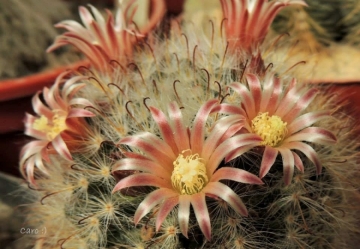 Chilita bocasana (Mammillaria bocasana) Photo by: Carolina González
Chilita bocasana (Mammillaria bocasana) Photo by: Carolina González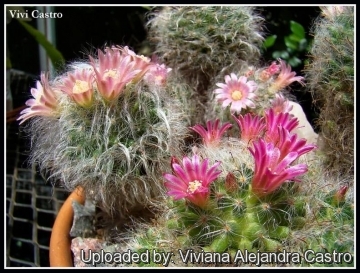 Chilita bocasana (Mammillaria bocasana) Photo by: Viviana Alejandra Castro
Chilita bocasana (Mammillaria bocasana) Photo by: Viviana Alejandra Castro Chilita bocasana (Mammillaria bocasana) Photo by: Carolina González
Chilita bocasana (Mammillaria bocasana) Photo by: Carolina González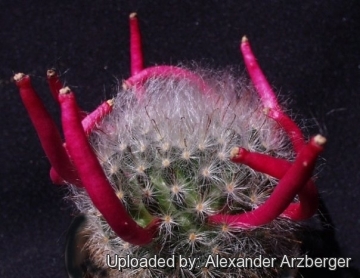 Chilita bocasana (Mammillaria bocasana) Photo by: Alexander Arzberger
Chilita bocasana (Mammillaria bocasana) Photo by: Alexander Arzberger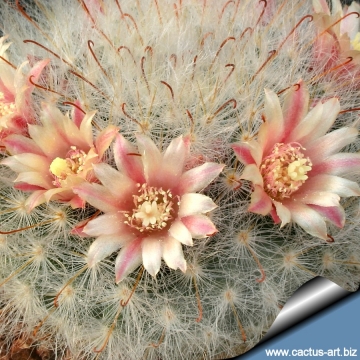 Chilita bocasana (Mammillaria bocasana) Photo by: Cactus Art
Chilita bocasana (Mammillaria bocasana) Photo by: Cactus Art Chilita bocasana (Mammillaria bocasana) Photo by: Giuseppe Distefano
Chilita bocasana (Mammillaria bocasana) Photo by: Giuseppe Distefano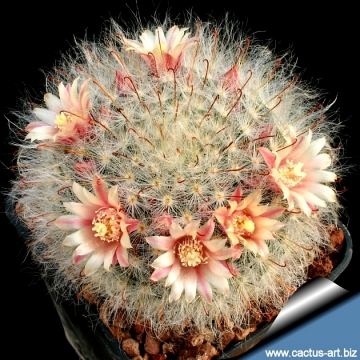 Chilita bocasana (Mammillaria bocasana) Photo by: Cactus Art
Chilita bocasana (Mammillaria bocasana) Photo by: Cactus Art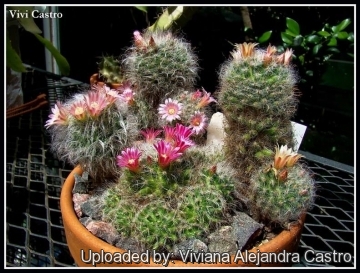 Chilita bocasana (Mammillaria bocasana) Photo by: Viviana Alejandra Castro
Chilita bocasana (Mammillaria bocasana) Photo by: Viviana Alejandra CastroCultivation and Propagation: Mammillaria bocasanaSN|8970]]SN|8970]] is a freely clustering species that reproduces easily by cutting. It is a great starter plant for the cactus grower, that readily builds up into a dense cluster of stems smothered by white hairs, further decorated by rings of cream or pale pink blooms.
Growth rate: It is a rapidly growing species. It offset from the base and can fill a 25 cm pot in just a few years given the best conditions.
Soils: It likes very porous standard cactus mix soil with little organic matter (peat, humus).
Repotting: Repotting every 2-3 years. As it is prone to rot under-pot in a smaller container filled with very porous compost. Use pot with good drainage.
Watering: Water regularly in summer, but do not overwater (very wet-sensitively, especially in light of its succulent root system). Its roots are easily lost in pots that stay damp for any length of time. Keep dry with ample airflow in winter. In the rest period no high atmospheric humidity!! Care must be taken with watering as they tends to become swollen and untidy in growth habit if given too much water and shade.
Fertilization: During the growing season enrich the soil using a fertilizer rich in potassium and phosphorous, but poor in nitrogen, because this chemical element doesn’t help the development of succulent plants, making them too soft and full of water.
Hardiness: It is quite frost resistant if kept dry, hardy as low as -5° C (some reports give it hardy to -12°C). However some warmth throughout the year will increase the grower's success (minimum 5° to 8°C during rest season).
Exposition: Outside bright sun, filtered sunlight or afternoon shade, inside it needs bright light, and some direct sun. Subject to sunburn if exposed to direct sun for too long. Tends to bronze in strong light, which encourages flowering and heavy wool and spine production.
Uses: It is an excellent plant for container growing. It always looks good and stays small. It look fine in a cold greenhouse and frame.
Traditional uses: The white, hooked spines of this spherical cactus were used as fish hooks in its native Mexico.
Pests & diseases: It may be attractive to a variety of insects, but plants in good condition should be nearly pest-free, particularly if they are grown in a mineral potting-mix, with good exposure and ventilation. Nonetheless, there are several pests to watch for:
- Red spiders: Sensitive to red spider mite. Overhead watering is helpful in controlling mites.
- Mealy bugs: Occasionally mealy bugs they develop aerial into the new growth among the wool with disfiguring results, but the worst types develop underground on the roots and are invisible except by their effects.
- Scales: Scales are rarely a problem.
- Rot: Rot it is only a minor problem with cacti if the plants are watered and “aired” correctly. If they are not, fungicides won't help all that much.
Propagation: Direct sow after last frost or (usually) or division . Seeds germinate in 7-14 days at 21-27° C in spring, remove the glass cover gradually as the plants develops and keep ventilated, no full sun for young plants! The seedlings should not be disturbed until they are well rooted, after which they can be planted separately in small pots. Cuttings: wait until the offsets that appear at the base of old clustered specimens are 1/3 the size of the parent and then detach and plant. Cuttings will take root in a minimum temperature of 20° C (but better in hot weather). Cuttings of healthy shoots can be taken in the spring and summer. Cut the stem with a sharp, sterile knife, leave the cutting in a warm, dry place for a week or weeks (depending on how thick the cutting is) until a callus forms over the wound. Once the callus forms, the cutting may be inserted in a container filled with firmed cactus potting mix topped with a surface layer of coarse grit. They should be placed in the coarse grit only; this prevents the cut end from becoming too wet and allows the roots to penetrate the rich compost underneath. The cuttings should root in 2 to 6 weeks.
Your Photos
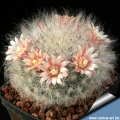
by Cactus Art



















